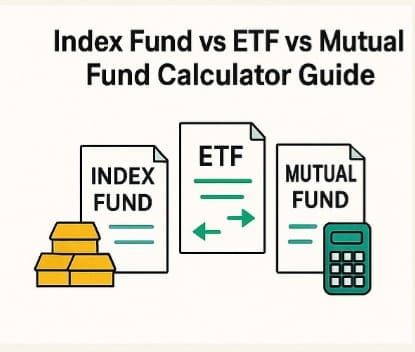Investing has become a lot more accessible these days. With just a few clicks, anyone can start investing in mutual funds, ETFs, or index funds. But while these sound kind of similar, they actually have different purposes — and when it comes to understanding returns, you also need to use the right calculator for each.
So, what exactly is the difference between:
- An Index Fund Tool
- An ETF Tool
- A Mutual Fund Tool?
Let’s break it down in the most beginner-friendly way possible — no complicated finance talk, just simple logic and helpful tools.

📊 What’s Common in All 3?
Before we go into the details, here’s what these calculators have in common:
- All show your investment returns over time
- All work based on inputs like amount invested, time, and return rate
- All help you plan or analyze your investment journey
But each one is designed slightly differently depending on the type of fund.
📈 Index Fund Calculator — For Passive, Long-Term Investors
An Index Fund is a type of mutual fund that tracks a market index — like the Nifty 50 or Sensex. Instead of trying to beat the market, it just matches the market. Because of that, it’s low-cost and great for long-term investors.
The Index Fund Tool is useful when:
- You want to invest monthly or lump sum in index funds
- You expect a stable return over 10+ years
- You want to compare index funds with other investment types
📌 Example:
Let’s say you invest ₹5,000 monthly in a Nifty 50 index fund expecting 11% returns over 15 years. The calculator tells you:
- You’ll invest ₹9,00,000 total
- Your fund could grow to over ₹21 lakh
That gives you a clear picture — and honestly, the simplicity of index funds makes them perfect for beginners.
🛠 Try our Index Fund Calculator
🔄 ETF Calculator — For Market-Savvy Investors
ETFs, or Exchange-Traded Funds, are similar to index funds but traded like stocks. That means:
- You can buy/sell anytime during market hours
- Prices fluctuate throughout the day
- You may pay brokerage fees
The ETF Tool is useful when:
- You’re investing lump sums into ETFs
- You want to see how your ETF performed
- You trade more actively
📌 Example:
If you bought ₹1,00,000 worth of an ETF 3 years ago and it has grown to ₹1,45,000, the calculator will show:
- Your profit: ₹45,000
- CAGR (Compounded Annual Growth Rate): around 13%
🛠 Try our ETF Calculator
This calculator is best for analyzing past performance and deciding if you should stay invested or switch.
💼 Mutual Fund Calculator — The All-Rounder
The Mutual Fund Tool is your go-to tool if you’re investing in any regular mutual fund (active or passive).
It works for:
- SIPs (monthly investing)
- One-time (lump sum) investments
- Equity, debt, hybrid funds
📌 Example:
You invested ₹2,000 per month in a mutual fund for 10 years and earned 12% return. The calculator tells you:
- Total invested: ₹2,40,000
- Expected maturity value: ₹4,66,000+
This is a great all-purpose calculator for both planning and tracking.
🛠 Try our Mutual Fund Calculator
🧠 So… What’s the Actual Difference?
| Feature | Index Fund Calculator | ETF Calculator | Mutual Fund Calculator |
|---|---|---|---|
| For Whom? | Long-term, passive investors | Active, short-mid term investors | Everyone |
| Investment Type | Passive mutual funds | Exchange-traded funds | All mutual funds |
| Flexibility | SIP + Lump sum | Mostly lump sum | SIP + Lump sum |
| Real-Time Pricing | No | Yes | No |
| Best For | Retirement goals, low fees | Short-term growth, trading | General investing |
🧭 Which Calculator Should You Use?
Index Fund Tool if:
- You’re investing for 10–20 years
- You like low-fee, low-stress investing
- You want to match the market, not beat it
ETF Tool if:
- You’re buying ETFs like stocks
- You trade or check prices regularly
- You want to compare fund performance over time
Mutual Fund Tool if:
- You’re investing via SIP or one-time in any mutual fund
- You want a general estimate of returns
- You don’t know whether your fund is active or passive
⚠️ Mistakes People Often Make in index fund vs ETF vs mutual fund calculator
- Thinking all calculators give the same results — nope!
- Using an ETF calculator for SIPs (it doesn’t work that way)
- Expecting fixed returns (returns in funds are always estimated)
- Not checking fees or taxes while planning
Remember, these calculators are estimators, not guarantees. But they’re still way better than guessing blindly or following random advice.
🙋♂️ Real Example — 3 Friends, 3 Goals
- Nisha is saving for retirement 25 years away. She chooses an index fund and uses the Index Fund Calculator to plan ₹6,000/month.
- Ravi is trading ETFs regularly. He uses the ETF Calculator to track performance and spot trends.
- Ankita invests ₹3,000/month in an active mutual fund. She uses the Mutual Fund Calculator to set her 7-year investment target.
Different tools, different people — but each gets the clarity they need.
✏️ Final Thoughts on index fund vs ETF vs mutual fund calculator
Choosing the right calculator can make your investment journey a lot less stressful. While index funds, ETFs, and mutual funds sound similar, they’re used differently — and so are their calculators.
You don’t need to use all 3. Just pick the one that fits your current plan:
- Want low-cost long-term investing? → Index Fund Calculator
- Trading and analyzing ETFs? → ETF Calculator
- Just getting started with mutual funds? → Mutual Fund Calculator
Try them yourself and see how your money might grow — it’s quick, free, and much better than guessing.
